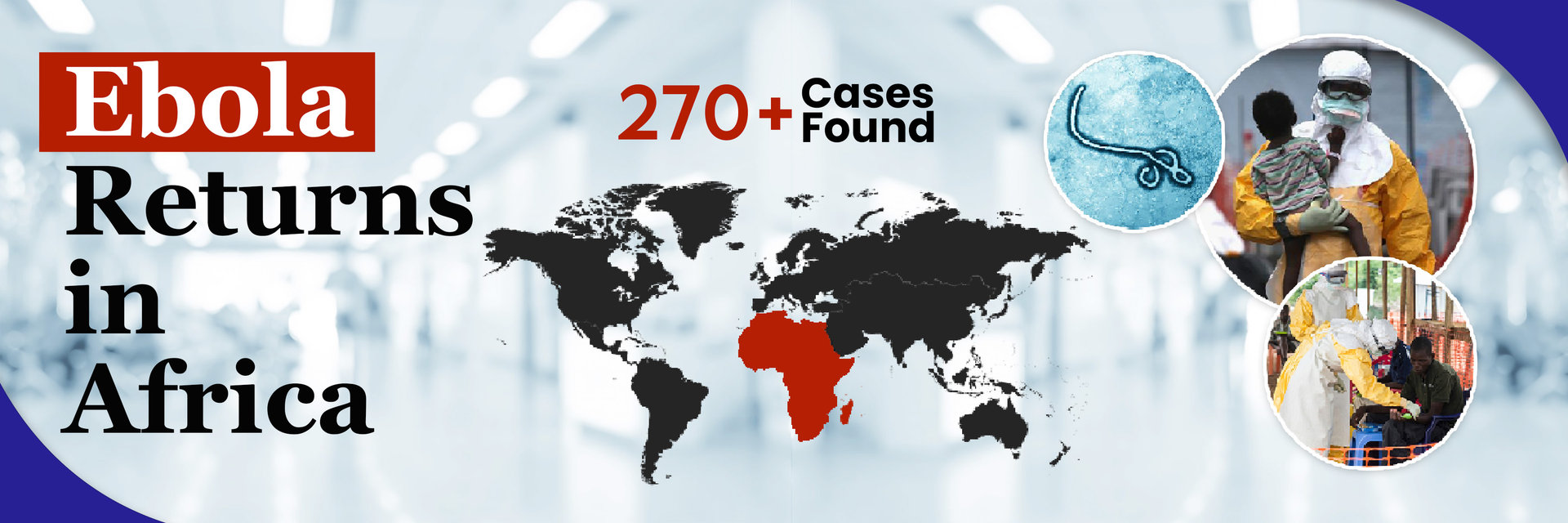
Ebola virus disease is not unknown to us. Ebola virus disease is a group of infections caused by multiple or groups of viruses in the genes that affect humans and non-humans like monkeys, gorillas, or chimpanzees. This virus is prone to specific regions of Sub- Saharan African countries. Across four decades, there have been 34 Ebola outbreaks, 14,823 deaths of 34,356 cases recorded with nearly 11 countries in Sub-Saharan Africa have recorded these Ebola outbreaks.
How does Ebola Virus spread?
The Ebola virus is contagious to some extent. A person can contract the Ebola virus if they come in physical contact with the infected patient. However, Ebola spreads through direct contact with the body, blood, or bodily fluids of the person infected or who has died because of ebola. Similarly, contact with infected animals such as monkeys, chimpanzees, and fruit bats can lead to Ebola infection.
Congo Ebola Outbreak 2022
Although persistent efforts to curtail its spread, sporadic Ebola virus cases still occur. The Ministry of Health announced the most recent outbreak in the Democratic Republic of the Congo (DRC) in the Mbandaka health zone, Equateur Province, on April 23, 2022. This is the third outbreak in the Equateur province, the first in 2018, followed by the second in the summer of 2020.
The reason for the Ebola virus in 2022 could be an African fruit bat or maybe even the source animal (reservoir host). However, scientists are still looking for evidence of the bat's role in the Ebola virus transmission.
Sequencing data from the first confirmed case in this outbreak indicates that the patient is a new spill-over event from an animal to a person and has no connections with the previous outbreaks.
The first victim of the Ebola virus was a 31 YO male suffering from fever and headache. He received anti-malarial drugs and antibiotics during his home treatment. Later on, he was shifted to two different medical units with no success in a span of five days. Finally, he was admitted to the General Referral Hospital in Wangata for treatment.
The second EVD case was of a 25 YO female from Mbandakala and a family member of the first EVD patient. She sought treatment at a prayer home, nurse home and pharmacy and finally died.
The Ministry of Health of the Democratic Republic of the Congo (DRC), in conjunction with WHO, is taking measures to prevent and control the outbreak. They have initiated measures such as isolations, laboratory confirmations, and checking at the entry checkpoints. Other preventive measures include -
- Administration of Ebola vaccination
- Only three patients have been tested negative from a batch of 270 suspected patients tested for the virus.
- Healthcare training is given to people
- Activation of the Alert system within the limits of the boundaries of the infected areas and the neighboring places
- Identification and establishment of 16+ points of control in Mbandaka
- On 24 April International Coordinating Group received approval to use Ervebo licensed vaccine. A total of 1307 does were stored in Goma, and 200 does with matching injections.
- Strict measures are taken to set up screening and isolation facilities at the Mbandaka Ebola Treatment Centre and other health facilities.
There is a high risk of Ebola Virus Disease in the Democratic Republic of Congo on account of multiple reasons, viz. presence of animal reservoirs, the host for the previous spill-over events, a high number of outbreaks, environmental changes, reduced capacity of the public health sector due to the other outbreaks of cholera, monkeypox, and COVID-19 pandemic coupled with violence and conflict. Furthermore, the city Mbandaka border is located on the Congo river making it challenging to close its border.
The World Health Organization suggests the following measures to further reduce the Ebola virus spread in West Africa.
- Reduction of contact between wildlife animals such as bats, monkeys, or apes and human beings is essential. Thorough cleaning of the meat of these animals to prevent transmission. The consumption of the meat of these animals should be restricted or reduced.
- Also, people should wear gloves and protective clothing when handling these animals.
- Male survivors should practice safe sex for 12 months or until their semen is tested negatively for the Ebola virus.
- Avoid body contact with a person infected with the Ebola virus. Also, regular washing with water and soap is advisable to stay safe.
- Vaccination is necessary for people who are likely to come in contact with infected persons.
The availability of PPE and Infection Prevention Control capacities need proper management to ensure an adequate and skilled workforce for managing Ebola-infected patients.
Ebola - Detection and Symptoms
Detection of Ebola is possible within ten days of getting infected or coming in contact with an infected person. The symptoms include fever, aches, weakness, fatigue, sore throat, loss of appetite, unexplainable hemorrhaging, rashes, bleeding, or changes in skin effects.
How to stay safe from the Ebola virus?
The Ebola virus is transmitted from wild animals to human beings, followed by human-to-human transmission. Hence, it is advisable to reduce contact with infected wild animals and the consumption of raw meat. Human beings should wear gloves and protective clothing when handling animals. In addition, animal meat, especially of bats, forest antelopes, or unknown animals (bushmeat) should be well-cooked before consuming it or avoided as much as possible
Protective gloves and apparel should be worn to reduce the risk of human-to-human transmission. Also, people should avoid direct or close contact with Ebola-affected people. In addition, caretakers and family members visiting or looking after Ebola-affected people should wash their hands regularly. They should avoid contact with the blood, body fluids, or personal belongings attending their funeral. It is advisable to abstain from sex till the tests reveal that the male partner does not have the Ebola virus.
History of the Ebola Virus and its outbreak
In 1976, Zaire and Sudan, located in Central Africa, were simultaneously affected by a fatal hemorrhagic fever. The Ebola virus was discovered in 1976 in Zaire and Sudan, both located in Central Africa. The then public health department assumed that travel of an infected person from one region to another led to its outbreak. The fevers were named Zaire-ebolavirus and Sudan ebolavirus accordingly. Later, it was observed that the Ebola virus was prevalent in people interacting with wildlife or consuming bushmeat.
From 2014 to 2016, most cases of Ebola Virus Disease were reported from the rural forest areas of southeast Guinea, which rapidly spread to the urban areas of Africa and soon resulted in a global pandemic. The West Africa Ebola epidemic in 2014-16 is one of the largest epidemics in world history.
During this period, the healthcare workers represented a mere 3.9% of the entire Ebola-affected population in West Africa, especially in the countries of Sierra Leone, Liberia, and Guinea combined. Moreover, nearly 74% of the transmission occurred due to direct contact with the dead bodies of the Ebola-affected patients, i.e. within the family.
Going forward, in order to tackle the Ebola Virus Epidemic, the government of these sub-Saharan countries are facing these challenges which can be overcome through extensive efforts in healthcare management especially in detection, vaccination, and treatment of the Ebola Virus patients accompanied by modernizing the relevant information technology services.
| Factor | Challenge | Opportunity |
| Epidemiological and ecological Factors | Ebola is endemic in western and central Africa | Establishing magnitude of EVD in the affected areas |
| Health System | Limited lab capacities Weak surveillance system Lack of effective medicines | Availability of serological lab technologies Adoption of new health facilities |
| Sociocultural | Limited community involvement | Adoption of health approach in communities in countries Availability in information and communication technologies |



